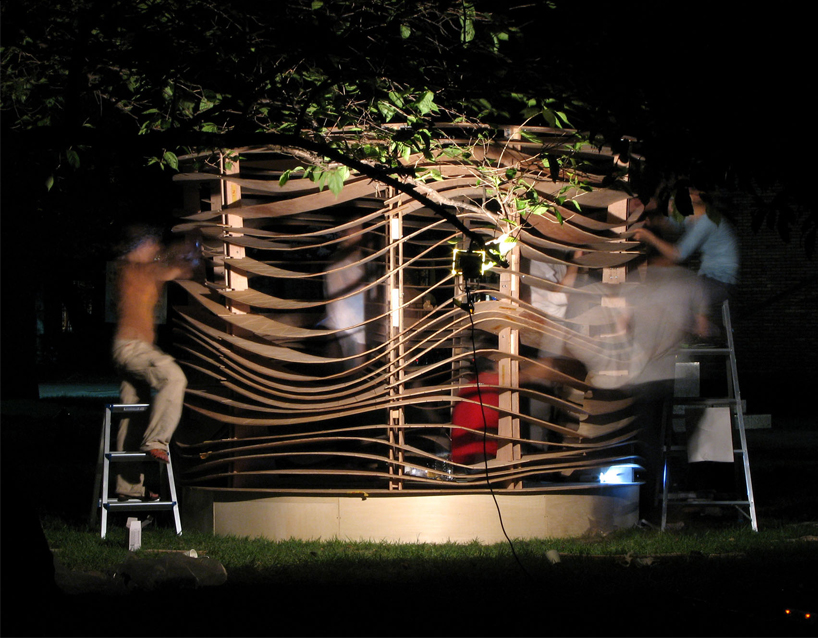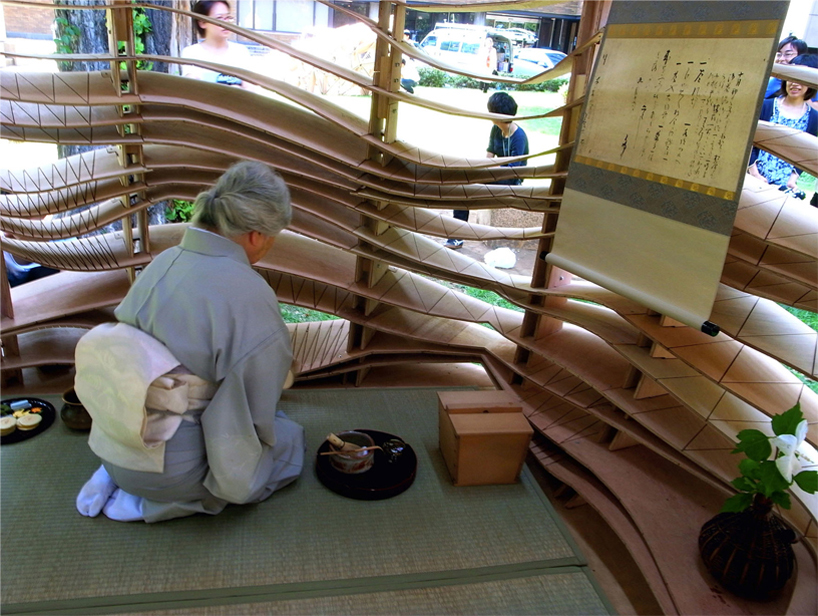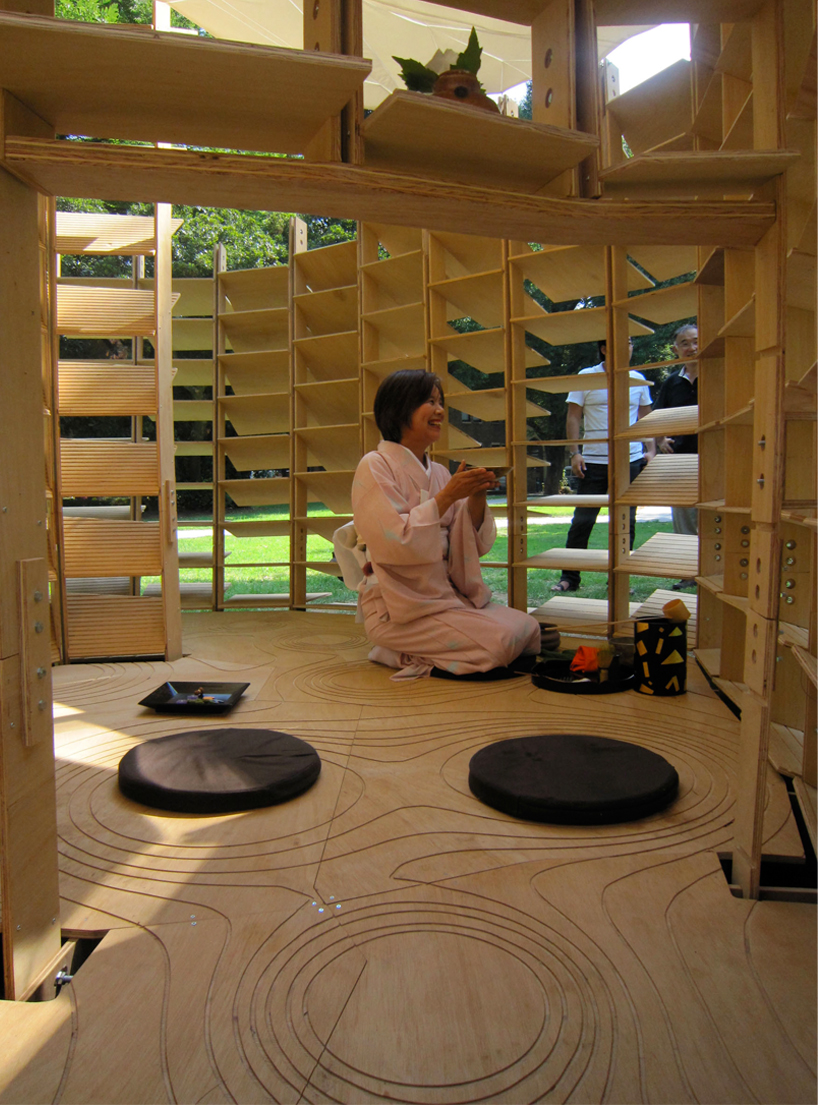
naminoma construction
image © alessio guarino photography
last august architecture students completed a study in bridging new technology with classic culture through the
design and fabrication of japanese teahouses during a summer workshop held at the university of tokyo. three teams
of 6 - 8 from the university of tokyo, department of architecture along with columbia university GSAPP fabrication lab
had one month to produce three full-scale tea houses to test their concepts, methodologies and materials.
the first part of the workshop introduced computational logic and concepts, which led to the second part of explorations
related to japanese tea ceremony culture that served as a pretext for further exploring digital design and fabrication tools.

naminoma - tea ceremony held inside
image © alessio guarino photography
the teams had the same constraints: the software grasshopper for rhinoceros (graphical generative algorithm tools
for 3d modeling), materials (9 mm and 12 mm plywood), budget, and manufacturing method (cnc routing). the outcomes
reflect the individual teams more than originally foreseen by the workshop's professors. particularly notable is a wide range
of issues addressed in the process for each of the pavilions, from applications of computational design, interpretations of tradition
and culture in spatial or activity oriented expressions, structural stability, and practical solutions for quick physical materialization.

left: view through the naminoma teahouse
right: aerial view of the GSAPP team's teahouse
images © alessio guarino photography
materiality of the plywood and taming them to achieve a more flowing form inspired by the imperfect tea bowl was
the theme for the pavilion 'nami-no-ma (space of waves).' the half-depth grooves in the plywood made by the cnc
router allowed for a typical flat-surface manufacturing to fall into the desired curvature along the cylindrical-shaped enclosure.

GSAPP tea ceremony
image © alessio guarino photography
the GSAPP team analyzed the essential elements of the two-tatami style teahouse to be able to generate a new
parametric design based on the traditional. each part of the ceremony - the participants, fixtures, and the tea itself -
influences a regulare panelized system, while the wall panels form an introverted space for the ceremony itself and
dually displaying it to the public.

GSAPP cnc cut plywood panels
image © alessio guarino photography
the GSAPP team pushed the aspect of parametric design to translate the traditional tea ceremony sequence of
separate host and guest entries, and the interior with attractor points designating positions of host, two guests, and
the tokonoma (recessed entrance space). the disjunction between limited amount of materials and the preferred
geometry were reconciled in the use of parametric adjustments in grasshopper software.

130008252010 view from guest entrance
image © alessio guarino photography
the pavilion '130008252010' focused on the precise moment of 13:00 p.m. on aug.25, 2010 when the tea ceremony
took place, for which to design a space with specific lighting conditions. interior space was determined by the software
in terms of the angles and depth of triangular patterned sun-shading device over a semi-conical surface of the arch structure.

130008252010 inside space shadow pattern
image © alessio guarino photography

'130008252010' tea ceremony
image © alessio guarino photography

'130008252010' inside rendering

naminoma - plywood bending tests and pieces assembly map

GSAPP assembly diagram
while technology can be seen as global phenomena, culture is still very much rooted in the local and national scale.
the workshop helped to make a clear example that such traditional values combined with new digital technologies is
not contradictory, as exemplified in the tea houses and enforced by the final tea ceremony held inside.
many thanks to the following for their support and dedication to the workshop:
university of tokyo, department of architecture kengo kuma lab / columbia university, GSAPP, phillip anzalone,
avery fabrication lab.
professors involved with the workshop: phillip anzalone, toru hasegawa, brigette borders (columbia university).
yusuke obuchi, tachi tomohiro, kaon ko, salvator-john a. liotta, nahoko yoshii (university of tokyo). keisuke toyoda,
motoki yamamoto, yusuke oono, alex knezo (noiz architects).
team 130008252010: tan toon cheng, david jenny, taichi kuma, reiko nishiyama, shuhei tanaka, haruka tomoeda, cui xuan.
team naminoma: anna braverman, kazami furukawa, akinori hamada, yuta ito, nikola nikolovski, hiroyuki tanaka.
team GSAPP: momo araki, yuval borochov, jordan carver, rachel hillery, teel lassiter, lindsay mcclelland, kristen munro, michael walch.
designboom has received this project from our 'DIY submissions' feature,
where we welcome our readers to submit their own work for publication.
- ۹۰/۰۶/۲۸





















